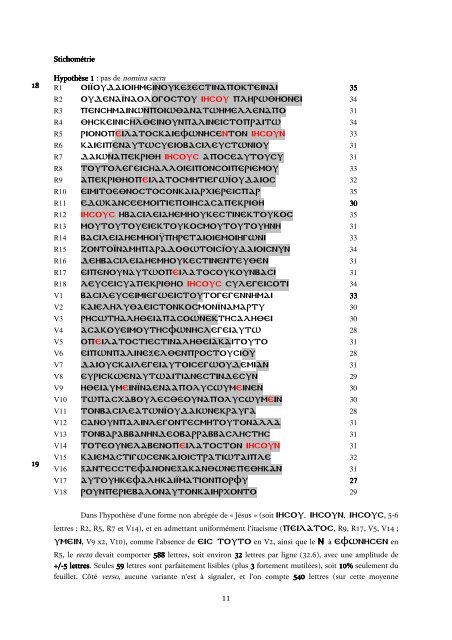Le P52 (P. Rylands.Gr.457) contenait-il un nomen sacrum pour "Jésus" ?
Examen de la présence ou non des nomina sacra dans le plus ancien manuscrit grec du Nouveau Testament.
Examen de la présence ou non des nomina sacra dans le plus ancien manuscrit grec du Nouveau Testament.
You also want an ePaper? Increase the reach of your titles
YUMPU automatically turns print PDFs into web optimized ePapers that Google loves.
18<br />
18<br />
19<br />
19<br />
Stichométrie<br />
Stichométrie<br />
Hypothèse Hypothèse 1 1 : pas de nomina sacra<br />
R1 oiIoudaioihmeinoukecestinapokteinai 35<br />
R2 oudenaInaologostou ihsou plhrwqhonei 34<br />
R3 penshmainwnpoiwqanatwhmellenapo 31<br />
R4 qhskeinishlqeino<strong>un</strong>palineistopraitw 34<br />
R5 rionope<strong>il</strong>atoskaiefwnhsenton ihso<strong>un</strong> 33<br />
R6 kaieipenautwsueiobas<strong>il</strong>eustwniou 31<br />
R7 daiwnapekriqh ihsous aposeautousu 31<br />
R8 toutolegeishalloieiponsoiperiemou 33<br />
R9 apekriqhope<strong>il</strong>atosmhtiegwIoudaios 32<br />
R10 eimitoeqnostosonkaiarxiereispar 35<br />
R11 edwkanseemoitiepoihsasapekriqh 30 30<br />
30<br />
R12 ihsous hbas<strong>il</strong>eiahemhoukestinektoukos 35<br />
R13 moutoutoueiektoukosmoutoutouhnh 31<br />
R14 bas<strong>il</strong>eiahemhoiUphretaioiemoihgwni 33<br />
R15 zontoInamhparadoqwtoisIoudaioisn<strong>un</strong> 34<br />
R16 dehbas<strong>il</strong>eiahemhoukestinenteuqen 31<br />
R17 eipeno<strong>un</strong>autwope<strong>il</strong>atosouko<strong>un</strong>basi 31<br />
R18 leuseisuapekriqho ihsous sulegeisoti 34<br />
V1 bas<strong>il</strong>euseimiegweistoutogegennhmai 33<br />
V2 kaielhluqaeistonkosmonInamartu 30<br />
V3 rhswthalhqeiapasownekthsalhqei 30<br />
V4 asakoueimouthsfwnhslegeiautw 28<br />
V5 ope<strong>il</strong>atostiestinalhqeiakaitouto 31<br />
V6 eipwnpalinecelqenprostousiou 28<br />
V7 daiouska<strong>il</strong>egeiautoisegwoudemian 31<br />
V8 euriskwenautwaitianestindes<strong>un</strong> 29<br />
V9 hqeiaumeinInaenaapoluswumeinen 30<br />
V10 twpasxaboulesqeo<strong>un</strong>apoluswumein 30<br />
V11 tonbas<strong>il</strong>eatwnIoudaiwnekrauga 28<br />
V12 sano<strong>un</strong>palinlegontesmhtoutonalla 31<br />
V13 tonbarabbanhndeobarrabbaslhsths 31<br />
V14 toteo<strong>un</strong>elabenope<strong>il</strong>atoston ihso<strong>un</strong> 31<br />
V15 kaiemastigwsenkaioistratiwtaiple 32<br />
V16 cantesstefanonecakanqwnepeqhkan 31<br />
V17 autouhkefalhkaiImationporfu 27 27<br />
27<br />
V18 ro<strong>un</strong>periebalonautonkaihrxonto 29<br />
Dans l’hypothèse d’<strong>un</strong>e forme non abrégée de « Jésus » (soit ihsou, ihso<strong>un</strong>, ihsous, 5-6<br />
lettres : R2, R5, R7 et V14), et en admettant <strong>un</strong>iformément l’itacisme (pe<strong>il</strong>atos, R9, R17, V5, V14 ;<br />
umein, V9 x2, V10), comme l’absence de eis touto en V2, ainsi que le N à efwnhsen en<br />
R5, le recto devait comporter 588 588 lettres, soit environ 32 32 lettres par ligne (32.6), avec <strong>un</strong>e amplitude de<br />
+/ +/-5 +/ lettres lettres. lettres<br />
Seules 59 59 lettres sont parfaitement lisibles (plus 3 fortement mut<strong>il</strong>ées), soit 10% 10% seulement du<br />
feu<strong>il</strong>let. Côté verso, auc<strong>un</strong>e variante n’est à signaler, et l’on compte 540 lettres (sur cette moyenne<br />
11



